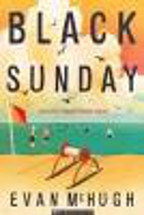Black Sunday by Evan McHugh

Omnibus, 2016. ISBN 9781743627990
(Age: 11-15) Recommended. In February 1938, the largest mass rescue
on an Australian beach took place when up to 300 people were swept
out to sea from Bondi. I knew very little about lifesaving before
reading this novel and found it informative and moving, to the point
that I now have some understanding of the immense pride and
affection that beachgoers have for their local lifesaving clubs and
brave members.
Suitable for eleven to fifteen year olds, the story is told in diary
form by Nipper, a boy of twelve who idolises his Grandfather and his
lifesaving colleagues who patrol the beach at Bondi. Normally I find
diary entry chapters tiresome, however the author has worked hard to
make the story more interesting than simply leading to the main
event, by setting time and place in the context of the
post-Depression years in the prelude to World War 2.
Sometimes writers of historical fiction feel compelled to include
every tiny detail of remote relevance from their research and there
is faint evidence of this. However on the whole it works well and I
completely understand why the author chose to do this, given that
modern readers may have little appreciation of the simplicity of a
time when children routinely left school at thirteen, possessions
were few and the sight of an aeroplane was a magical wonder.
Some might consider the inclusion of Indigenous, environmental,
gender, refugee and geopolitical issues to be a little busy and
contrived. This is because they are all tied in to the story and
certain characters voice modern, socially acceptable points of view
as a counter to the prevailing attitudes of the time. This will
however help younger readers understand historical perspective.
Importantly, this is an exciting story with plenty of structure and
drama which recounts an amazing historical event without being a
boring lesson. On this momentous day, a series of colossal, freak
waves dragged hundreds of people far out to sea in dangerous rips
which prevented their return. By chance, a large number of
lifesavers beyond those on duty were present for training and they
soon plunged into action. What happened was truly stunning and the
reader is brought to understand the enormity of the feat by Nipper's
description of rips and long training periods where he tries to
improve his swimming to a standard which will serve him in later
years as a lifesaver.
Informative historical notes are included at the conclusion of the
story.
This delightful book would make an excellent text for study at
senior primary level and libraries should consider it for general
reading.
Rob Welsh